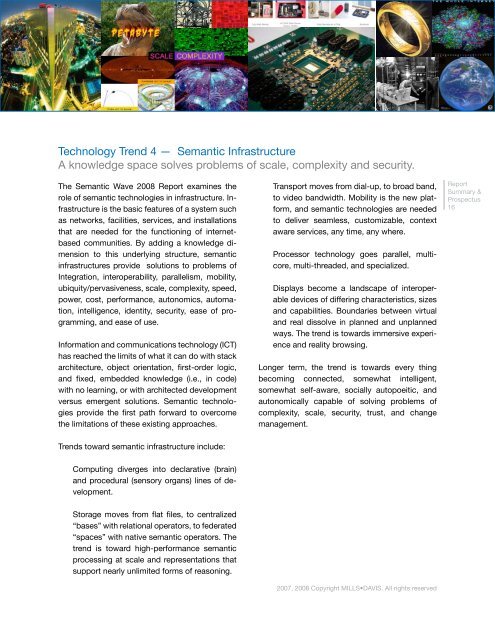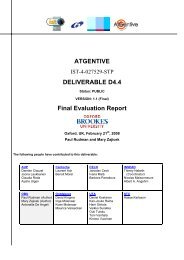Industry Roadmap to Web 3.0 & Multibillion Dollar ... - INSEAD CALT
Industry Roadmap to Web 3.0 & Multibillion Dollar ... - INSEAD CALT
Industry Roadmap to Web 3.0 & Multibillion Dollar ... - INSEAD CALT
Create successful ePaper yourself
Turn your PDF publications into a flip-book with our unique Google optimized e-Paper software.
Technology Trend 4 — Semantic Infrastructure<br />
A knowledge space solves problems of scale, complexity and security.<br />
The Semantic Wave 2008 Report examines the<br />
role of semantic technologies in infrastructure. Infrastructure<br />
is the basic features of a system such<br />
as networks, facilities, services, and installations<br />
that are needed for the functioning of internetbased<br />
communities. By adding a knowledge dimension<br />
<strong>to</strong> this underlying structure, semantic<br />
infrastructures provide solutions <strong>to</strong> problems of<br />
Integration, interoperability, parallelism, mobility,<br />
ubiquity/pervasiveness, scale, complexity, speed,<br />
power, cost, performance, au<strong>to</strong>nomics, au<strong>to</strong>mation,<br />
intelligence, identity, security, ease of programming,<br />
and ease of use.<br />
Information and communications technology (ICT)<br />
has reached the limits of what it can do with stack<br />
architecture, object orientation, first-order logic,<br />
and fixed, embedded knowledge (i.e., in code)<br />
with no learning, or with architected development<br />
versus emergent solutions. Semantic technologies<br />
provide the first path forward <strong>to</strong> overcome<br />
the limitations of these existing approaches.<br />
Transport moves from dial-up, <strong>to</strong> broad band,<br />
<strong>to</strong> video bandwidth. Mobility is the new platform,<br />
and semantic technologies are needed<br />
<strong>to</strong> deliver seamless, cus<strong>to</strong>mizable, context<br />
aware services, any time, any where.<br />
Processor technology goes parallel, multicore,<br />
multi-threaded, and specialized.<br />
Displays become a landscape of interoperable<br />
devices of differing characteristics, sizes<br />
and capabilities. Boundaries between virtual<br />
and real dissolve in planned and unplanned<br />
ways. The trend is <strong>to</strong>wards immersive experience<br />
and reality browsing.<br />
Longer term, the trend is <strong>to</strong>wards every thing<br />
becoming connected, somewhat intelligent,<br />
somewhat self-aware, socially au<strong>to</strong>poeitic, and<br />
au<strong>to</strong>nomically capable of solving problems of<br />
complexity, scale, security, trust, and change<br />
management.<br />
Report<br />
Summary &<br />
Prospectus<br />
16<br />
Trends <strong>to</strong>ward semantic infrastructure include:<br />
Computing diverges in<strong>to</strong> declarative (brain)<br />
and procedural (sensory organs) lines of development.<br />
S<strong>to</strong>rage moves from flat files, <strong>to</strong> centralized<br />
“bases” with relational opera<strong>to</strong>rs, <strong>to</strong> federated<br />
“spaces” with native semantic opera<strong>to</strong>rs. The<br />
trend is <strong>to</strong>ward high-performance semantic<br />
processing at scale and representations that<br />
support nearly unlimited forms of reasoning.<br />
2007, 2008 Copyright MILLS•DAVIS. All rights reserved
















